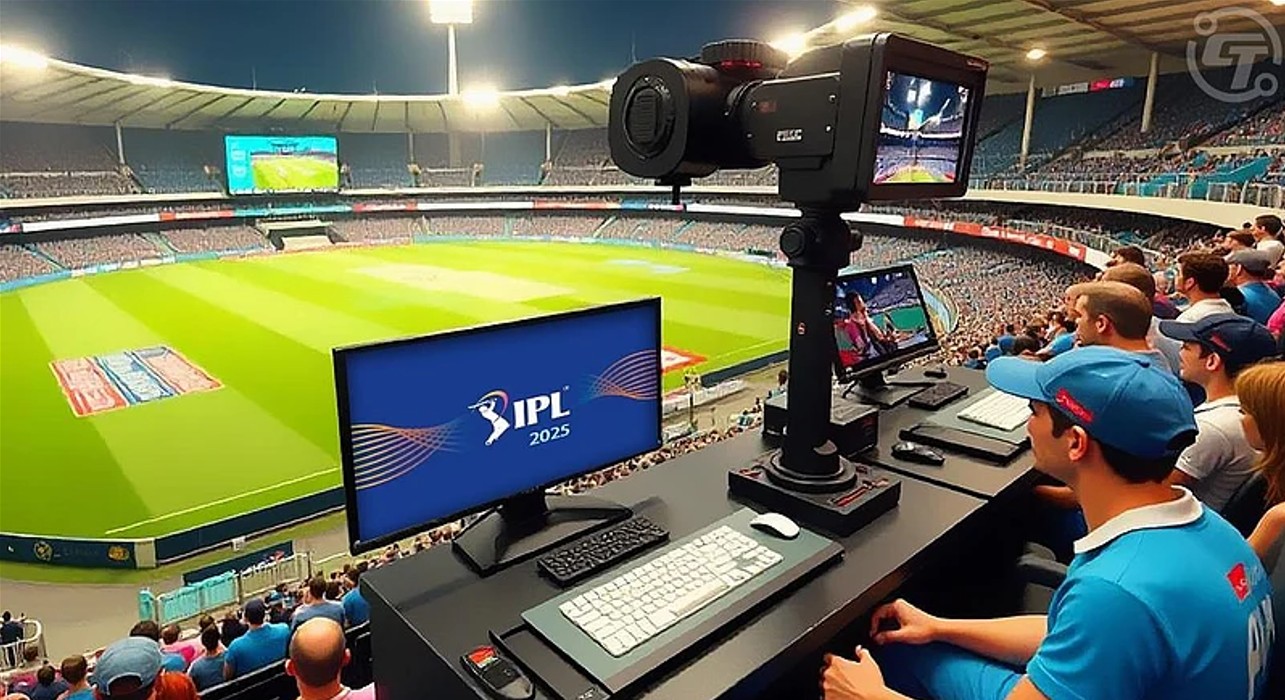When one watches an Indian Premier League (IPL) match today, one is not just watching a game of cricket. One is watching a high-tech data spectacle, a fusion of live sport and cutting-edge technology that has fundamentally changed the game.
The View from Everywhere: Spidercam and the Drone Revolution
The first and most obvious revolution is in the camera work. The old, static, side-on view of the game is a relic. Today, the broadcast gives the viewer a god’s-eye perspective. The most visible tool is the Spidercam. A robotic camera suspended by a complex web of cables, it can float, swoop, and glide silently above the players, following the ball from the bowler’s hand to the boundary rope. It provides a dynamic, fluid perspective that immerses the viewer in the action in a way that was once impossible. Joining the Spidercam is a growing fleet of high-speed drones. These drones can track a fielder running along the boundary or provide stunning aerial shots of the stadium, adding a new layer of cinematic quality to the broadcast. This is no longer just a recording of a sporting event; it is a meticulously directed visual experience.
The Science of the Seam: Hawk-Eye, Ball Tracking, and the DRS
The most powerful technology is the one the viewer can’t see. The heart of the modern broadcast and the Decision Review System (DRS) is a sophisticated ball-tracking system, most famously provided by Hawk-Eye. A network of multiple, high-speed cameras positioned around the stadium all track the cricket ball from the moment it leaves the bowler’s hand. A powerful computer triangulates the position of the ball from these different feeds, creating a precise, three-dimensional reconstruction of its trajectory. This predictive power is the heart of the modern game, settling debates with data. The real-time data stream generated by these systems doesn’t just end up on the broadcast; it fuels the entire digital ecosystem around the sport. This is the kind of information that supercharges the experience for the engaged fan, whether they are playing fantasy sports or using a desi betting app to follow live odds. For the umpire, however, this single data point-the predicted path of the ball-is all that matters.
The Whisper on the Bat: UltraEdge and the Snickometer
The second pillar of the DRS is a technology that is aimed at picking up the slightest of noises. One of the most difficult decisions an umpire has to make is whether the ball has hit the bat in the tiniest of touches. This is where the so-called UltraEdge (or the Snickometer) comes in. The audio feed is isolated by the system in the use of highly sensitive microphones incorporated into the stumps at both ends of the wicket. It then matches this audio with super-slow-motion video of the ball cutting the bat. Audio waveform is analyzed through the software of the system. There is a slight contact between leather and wood that gave a very specific, sharp spike in the waveform at the moment when the ball is through the bat on the video. A ball that strikes the pad of the batsman instead, on the other hand, produces a rounded, gentler waveform. This enables the third umpire to get a view with unbelievable accuracy, as to whether there was a murmur of contact.
Beyond the Score: The Real-Time Analytics Boom
The modern IPL broadcast is a relentless stream of data, presented to the viewer as sleek, informative graphical overlays. This is the world of real-time analytics. These are not just simple statistics; they are complex data visualizations that deepen the viewer’s understanding of the game as it unfolds.
- The Win Predictor: An algorithm that constantly updates a team’s probability of winning based on the current score, run rate, and historical data.
- Wagon Wheels: A visual representation of where a particular batsman has scored all their runs, revealing their strengths and weaknesses.
- Pitch Maps: A graphic showing exactly where a bowler has been landing the ball, revealing their strategy and consistency.
This constant flow of data has transformed the way commentators analyze the game and has given the average fan a level of tactical insight that was once reserved for professional coaches.
Powering the Second Screen: The Data That Fuels Fantasy Sports
The television broadcast is not the only place this river of real-time data exists. It is the blood of the mega-ecosystem of the second screen, especially the fantasy sports business. The introduction of sites such as Dream11 has made the IPL a part of millions of fans. These sites are fueled by a live official data feed that is direct game. Each run, each wicket, each ball bowled is immediately converted to a data point that updates the fantasy points of all of the millions of users. Stadium technology is not only targeted to the umpires and the television viewer, but to the driving force behind an entire new set of layers of interactive competition, fans can transition out of the passive participant, into an active participant who is controlling his or her own team and competing with friends in real-time.
Conclusion: A More Intelligent Viewing Experience
The technology that drives the modern IPL broadcast has not only made the game look good, but also has achieved more. It has enhanced the whole experience to be more intelligent, profound, and more interesting. It has introduced a previously unseen degree of precision to the decisions of the umpires, provided commentators and spectators with an abundance of information to analyze, and has established a flourishing online ecology where a more active type of participation is possible. The Spidercam, the Hawk-Eye and the never-ending flow of analytics are not mere gimmicks and they have become the indispensible tools that have made us watch and comprehend the game in a new manner. They are the new all-seeing eye of the umpire and they have produced a richer and smarter viewing experience to all.









